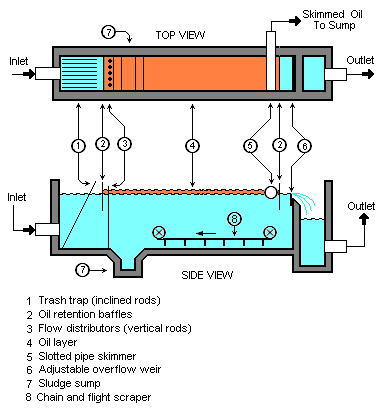The Origins
Simple gravity separation is where the marketplace began to deal with the removal of oil from water as well as spill containment. Many older large holding tanks are commonly referred to as API oil/water separators, referring to the American Petroleum Institute who created the design parameters for certain flow rates. The American Petroleum Institute provides design criteria for oil/water separators. A design method is provided in the API Manual on Disposal of Refinery Wastes, Chapters 5 and 6- Oil-Water Separator Process Design and Construction Details (API publication 1630, 1979).

The API oil/water separator is a simple gravity separation device designed by using Stokes Law to define the rise velocity of oil droplets based on their density and size. The design of the separator is based on the specific gravity difference between the oil and the wastewater because that difference is usually smaller than the specific gravity difference between the suspended solids and water. Based on that design criterion, most of the suspended solids will settle to the bottom of the separator as a sediment layer, the oil will rise to top of the separator, and the wastewater will be the middle layer between the oil on top and the solids on the bottom.
Advantages of the API separator are simplicity of design, low day-to-day maintenance, and resistance to plugging with solids.
(Below is an excerpt from a presentation Mercer gave at an online Wastewater conference)
Drawbacks:
API oil/water separators are designed to remove oil droplets down to 150 micron, which is not nearly enough removal necessary to stay compliant today. Most API oil/water separators are not going to do any better than 50 parts per million as opposed to most state & federal regulations that today require below 20 ppm.
Most industries have abandoned building these large gravity settling vessels because they are simply too costly to justify. Most are built of concrete and with the high cost of labor and the need to reinforce these tanks with steel, new construction costs rise quickly. Plus API units have an excessively large footprint and are far too much of a real estate burden to consider this as a viable option.
Those who have API oil/water separators acknowledge they are easy to operate and maintain on a day-to-day basis, but when it is time to clean out the tank, the cost to pump out the sludge and clean this large space is just a nightmare. Some units have a chain and scrapper mechanism. This helps move the solids to one side to be pumped out, but the automation piece for these are usually as much as the construction of the pit itself—and require significant maintenance as well.


